We’re all guilty of indulging in some heck-of-the-moment shopping without using more than 2 brain cells to think beyond that one moment. I wouldn’t blame you if you got swept away and placed an order for a kayak without even thinking twice about where you can store it or how to even transport it.
Kayaking has for ages been one of the most interesting and absorbing sports that anyone can indulge in. You get to enjoy fresh air, and healthy exercise, get in touch with Mother Nature and even go fishing if you’re feeling like it. However, the technicalities that come before all this process are… well, very important!
After purchasing your kayak, it’s a bit challenging to safely transport your boat to and from the water body you intend to romp around in. However, all you really need is a truck and some basic accessories, and you no longer have to wonder how to transport a kayak in a truck.
Kayak Trucks – a Feasible & Practical Option
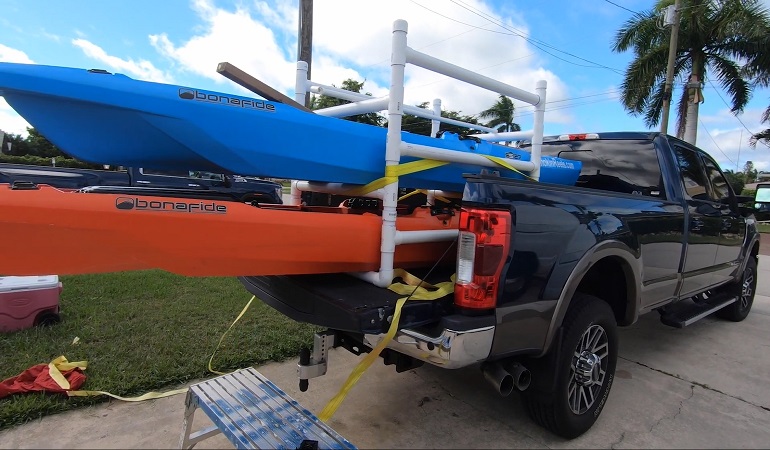
If you have a pickup truck and a kayak, then that is all you need to officially kickstart your kayaking journey. And no, not just any car will do! Kayaks are big and bulky, and if you are careless with transporting them, then you could land yourself in a lot of trouble.
Take it from my dear friend Samuel who decided to tie their kayak (with rope) to the roof of their small Honda Civic, and it ended up landing on a freeway in Montreal, blocking the road for a long line of traffic behind him.
Therefore, I must emphasize the requirement of pickup trucks or bigger cars for this kind of work
How To Transport A Kayak In A Pickup Truck Bed Safely
Let’s find out various options that you can utilize to transport a kayak in a truck safely to your destination.
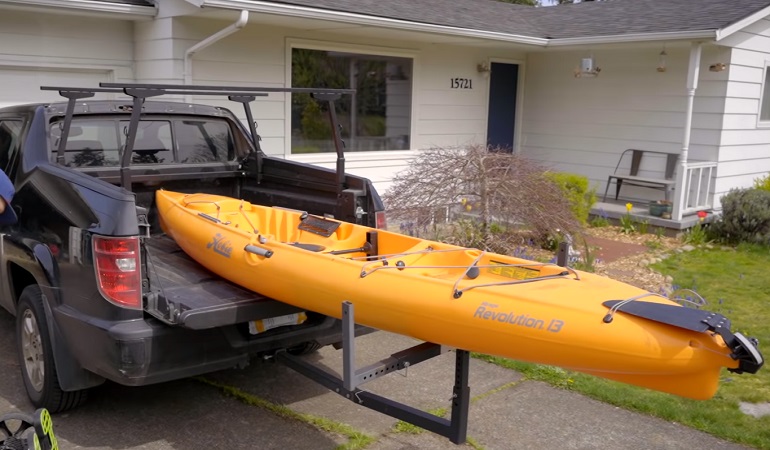
Truck Bed
There is no rocket science to knowing how to transport a kayak in a truck when you have an entire truck bed just sitting right there for ya!
This is the easiest and most popular method of kayak transportation that requires no additional fixtures to your car. All you need to ensure is that your kayak is laid atop a truck bed liner with a rubber mat to protect your additional gear.
If you are planning to travel long distances or are just specifically very particular about your kayak’s upkeep, then I recommend foam blocks to safely transport your kayak.
They assist in guaranteeing your boat doesn’t move from one side to another while you’re driving and hence reducing the possibility of damage to your kayak.
However, my best tip to transport a kayak safely in a truck bed is to use cable locks. I like to loop one cable lock around each kayak handle and fasten it to an anchor point on the inside of the truck bed. In that way, the kayak is fastened from all its sides, and not even the sharpest turns I make can dislodge it.
Roof-mounted Kayak Rack System
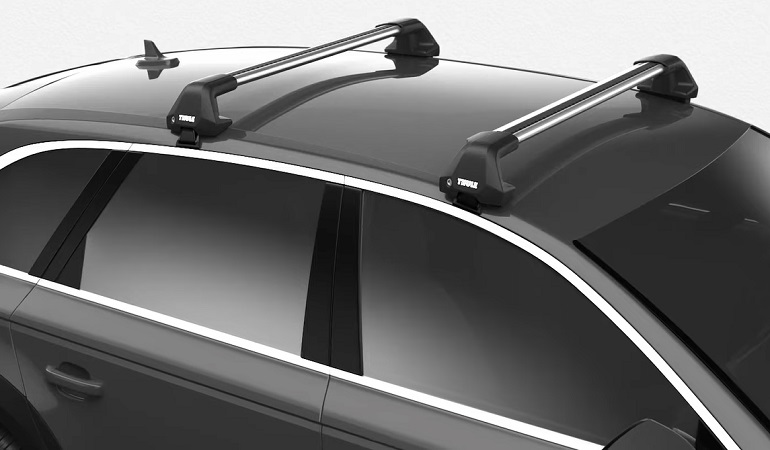
Sometimes your truck bed is not the best option for transporting a kayak.
Why?
Well, in case you have a lot of additional gear and are leaving the pickup truck bed for that –your kayak won’t have much space. Or maybe you have more than one kayak that needs transporting, so the truck bed is not enough. In either case, a roof rack system comes in very handy.
A truck kayak roof rack is basically like a temporary shelf that you can fix atop your truck cab to hook your kayak onto it. The perfect alternative to truck beds, a roof rack is a conveniently versatile option that can be customized in accordance with the vehicle you own and requires no drilling or extra equipment like tie-down hooks.
For example, if you own an SUV and purchase a roof rack for it, there is a big possibility that the same roof rack can also be utilized on pickup trucks as well. If you ask me, it is quite a feasible and affordable option.
However, a word of advice, something that I learned the hard way, remember to securely tie the bow and stern of your kayak to the roof rack. Because your kayak is practically airborne, the intensity of the wind maximizes in proportion to your speed and your surroundings.
If you’re traveling on a highway, the wind force is bound to be very strong, so it wouldn’t hurt to double and triple-check if the bow and stern are fastened.
And just to stay on the safe side, use your favorite straps to tie it down the middle to the roof rack system. A little security never hurt anyone! You can learn how to tie your kayak to a roof rack in order to transport it safely to your destination.
Kayak Truck Rack
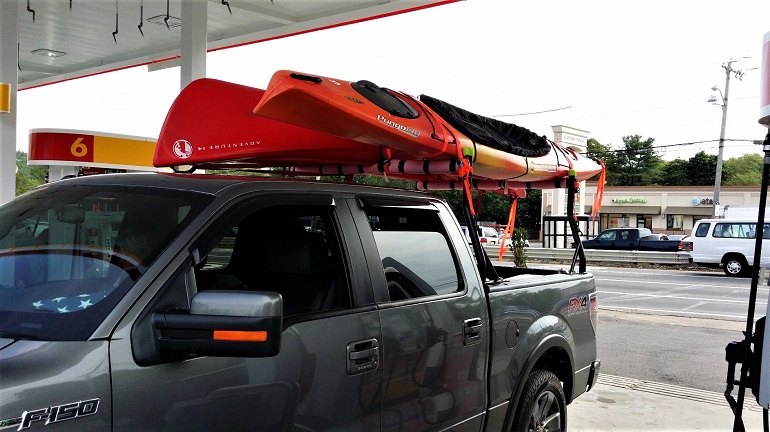
Kayak truck racks are another highly convenient method for those who want to learn how to transport a kayak in a truck, but unfortunately, their vehicle isn’t big enough. Where your kayak’s length is greater than your car’s, you need a kayak rack.
This nifty gadget is to be placed in your truck bed, but once you situate your kayak atop it, the kayak hull and body are well above the roof of your car. It helps elevate your boat, therefore giving it more room and space to sit freely.
All you have to do once your roof rack is set in place on the truck bed is put your kayak’s hull side down, fasten it securely to the bars and make sure it is angled in the center. The process is fairly easy and more advantageous than a roof rack system, even as it makes unloading and loading the boat 100 times easier.
Moreover, the weight capacity of your truck’s bed rack is more than a roof rack because… duh! There is no looming fear of the roof collapsing on the drivers or passengers. However, if you don’t have the specified vehicle then you can also learn how to transport 2 kayaks without a roof rack safely.
However, some may not completely warm up to the idea of a truck rack as to set it up, you require permanent mounts that may not be feasible for those avoiding such a hassle. They also cost a bit more.
Truck Utility Rack
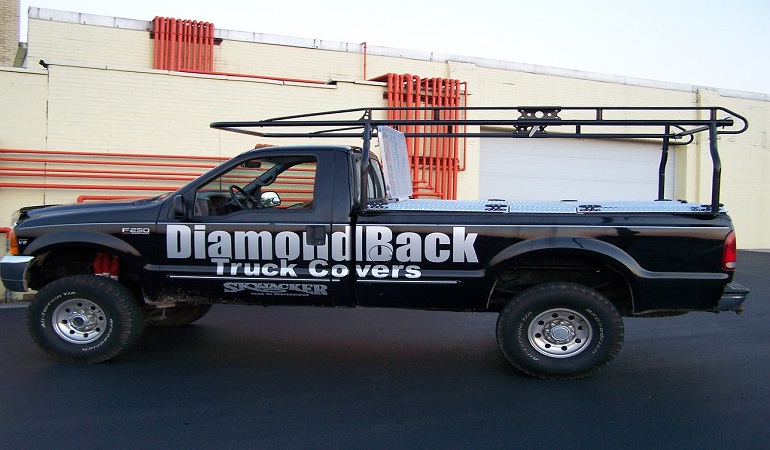
Possibly the best option out of all of them, a utility rack is practically a roof rack + truck rack package deal. Not only does it make room for 2 kayaks, but it also frees up a majority of your truck bed space so you can store any other gear you have on you.
It easily attaches to the bed of your pickup truck just like a truck rack would, but it has more anchor points and storage areas than that kind of rack. Even though a utility rack is way better and more practical than any other option, it does pose a difficulty when you actually place your kayak on top of it.
Due to the heaviness of your kayak, it could be impossible for you to singularly lift and place it on top of the truck’s bed and then up to the rack. Therefore you will definitely need a second helping hand. However, when you do manage to get it up there, use cam straps and stern lines to securely attach it to the rack.
Truck Bed Extender
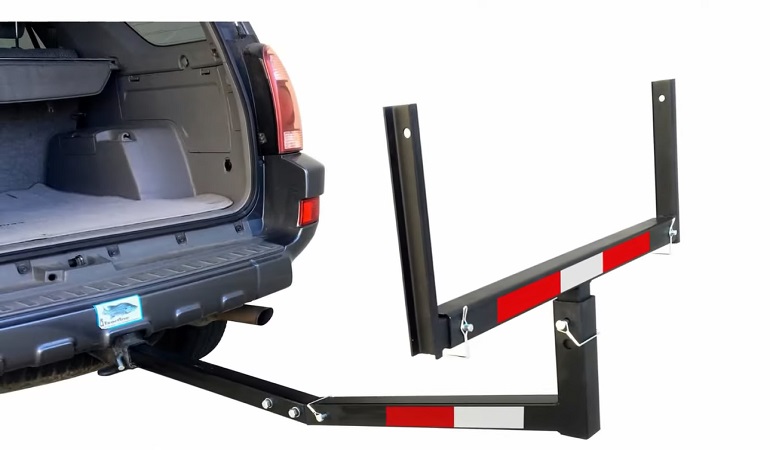
It’s really not your fault if your pickup bed is enough to accommodate the length of your kayak. But that also doesn’t mean you should be ditching either one of your vehicles. A truck bed extender was the perfect fix for me in 2012 when my Toyota pickup truck bed proved to be too cramped for my 10-foot kayak.
A truck bed extender can help you transport a kayak by extending your pickup bed by 2 feet extra. There is no uniform size that you can purchase from any shop, as the type and shape of every extender differ for every car model.
Laws Regarding Kayak Transport in a Truck
Let’s look at a number of laws governing the transportation of kayaks in a truck.
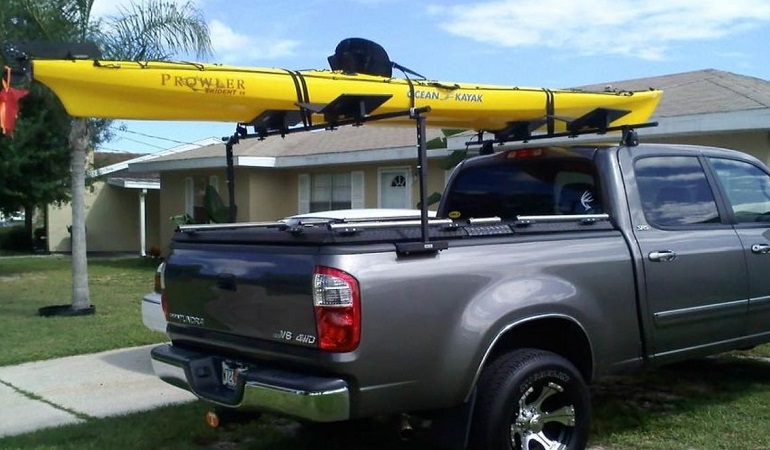
Your Tailgate: Up or Down?
The tailgate of the truck is like the gate that, when open, can of course make way for extra space but brings its fair share of disadvantages with it. By keeping it closed, the truck bed space is secure and barricaded; which is advantageous in its own way.
With the tailgate open, the unloading of your kayak from the truck bed is made twice as easy. All you have to do is slide the bad boy down, and out it pops.
I like to travel short distances with the tailgate open as it is hassle-free and also helps me situate the boat in line with the truck (without the boat extending way too out of the truck’s perimeter).
However, for longer distances, I wouldn’t recommend keeping the tailgate down as it basically cancels out the option of stowing any gear/equipment at the back. A swift brake would send my bags sliding right out of the truck bed… which isn’t very convenient, as you guys can tell!
As for keeping the tailgate up, there are no downsides to that…that’s literally the only logical way to transport a kayak in a truck. But it would just lengthen the time you take to unload your kayak, and maybe lessen the available space too.
The Cockpit: Up or Down?
The cockpit of your truck is basically the driver’s cabin i.e the interior car part of your truck. Loading your kayak in a truck bed with the cockpit facing upwards will help you extract your boat more easily once you reach by loosening its cam straps and sliding it down.
Nevertheless, it stays a personal preference choice as it makes no material difference if the cockpit is facing down or up. Some kayakers are in the habit of strapping their kayak in a truck bed with its hull pointed downwards, but I’ve found that this encourages it to slide around and move a lot while driving.
I, unlike other drivers, prefer to load my kayak, with the cockpit facing up. Contrary to loading it with the cockpit facing down this method won’t expose the backs of the seats to a lot of damage in case of any abrupt motion.
Keeping a Kayak Secure While the Tailgate Is Down
When it comes to fastening your kayak in a pickup truck bed, I always choose cam straps over ratchet straps because of their durability and gentleness on the kayak’s body regardless of how strongly I secure it. Ratchet straps may dent or bend your kayak at certain angles if pulled too much.
The length of the two straps you will use to secure your kayak to the truck bed should be approximately 15 feet in length. One fastens at the front of the boat and the other at the back, and both will be threaded through your truck bed tie-down points.

The trick is to run the straps at the back through each of the anchor points in the corners and pull the cam strap slowly and smoothly across the kayak’s top… do not yank it too hard!
Whereas at the front, you will need to use your cam strap and run it through one of the anchor points, as usual, but instead of running it atop the kayak, you need to find a durable point on top of your boat to run it through there.
I recommend searching for a loop or a socket about one-third of a way beyond the bow or stern. Loop the cam strap through there and run it back through another one of the anchor points and fasten.
Keeping a Kayak Secure While the Tailgate is Up
This method relies completely on your ability to angle your kayak in the truck’s bed. I find that the best angle is achieved by fitting the bow snugly into one of the front corners of the truck bed and leaving the stern to jutt out a bit over the farthest opposite corner in the rear end of the vehicle.
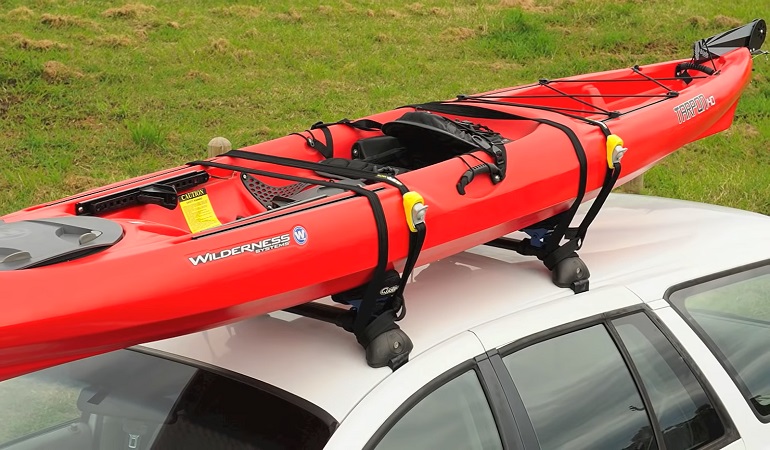
Once again, I recommend using a cam strap over any of those ratchet straps. The method of securing and strapping in your kayak with the tailgate up is very similar to the one where your tailgate is down.
The only difference is don’t fasten your straps to the anchor points all the way through and then move to the opposite corner of the kayak. Do it slowly and simultaneously bit by bit to adjust to the angle perfectly and avoid any mishaps.
A Reminder Regarding Kayak Anchor Point Selection
To fasten a kayak securely in your pickup truck bed you need to select key anchor points on its body. Only go for those points on the kayak’s body that are screwed in, bolted, or fused to it. D rings are available on most kayaks and are a popular choice because they are both reliable and accessible.
Although they are tighter in girth compared to the anchor points on your truck’s bed, a cam buckle can easily slip through them. Grab handles are also another great option. If you own a sit-on-top kayak, the scupper holes situated in the cockpit can accommodate the cam buckle too.
Cautioning Other Drivers By Flagging Your Kayak
Regardless of whether the tailgate is up or down, your kayak will be hanging over the edge of your bumper taking up a lot more road space than your usual truck would. Most states require you to take extra precautions to alert other drivers about this extended space.
No, you don’t have to get a permit from the state! Don’t be silly!
Simply tie a brightly colored rag or a red flag to the toggle handle at the end of the kayak and make sure it clearly contrasts with the kayak’s color.
The Best Way to Transport a Kayak in a Truck Bed with a Tonneau Cover

I know it looks real cozy once the tonneau cover is set up. Like… what could ever go wrong? Everything! Regardless of whether the truck bed is installed with the tonneau cover or not, you need to always strap your kayaks to your truck beds. When I tell y’all I speak from experience… don’t even get me started!
A word of warning for those truck owners who like to transport their kayak with the tonneau cover up but the tailgate down, do not stash any additional gear in the truck bed. With the tailgate down, no matter how protective the tonneau cover is, unsecured cargo will slip right out onto the road.
What’s the Largest Kayak I Can Fit in a Truck Bed?
Depending on the apparatus you have, and the vehicle you own a longer kayak with a length of up to 16 feet can be adjusted and safely transported. For example, 8-foot truck beds can accommodate up to 16 feet of kayaks. However, kayaks of this length can also be transported on 6-foot truck beds with the help of a utility rack.
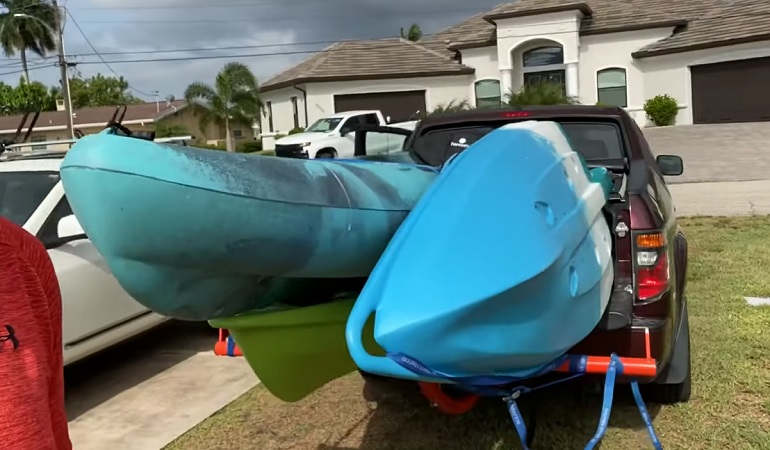
Top Advice & Tips for Transporting A Kayak In A Pickup Truck
I always emphasize the importance of following local laws and state rules. Not only is it essential as your responsibility to other drivers on the road but it also ensures nothing and no one interrupts your perfectly planned excursions with a ticket/accident. Especially where it concerns ‘overhang laws’.
Other than that, the key part of transporting a kayak is to ensure that it sustains zero damage. To guarantee that, take all the extra precautions you need. From purchasing a truck bed mat to non-slip foam blocks for added support; do what you need to. You’ll never regret a sustainable purchase.
Other useful tips I can remember off the top of my head include:
- Always make sure that 70% of your kayak’s weight is supported by the truck, especially in the case of overhang.
- A kayak cover is a great investment to protect it from the elements if you’re traveling long distances.
- Check, check, and double-check your setup before finally driving off and starting your journey.
- If you’re in for a long trip, make occasional stops every now and again to check and ensure all is well at the back (or at the top in case of a roof rack)
- Adapt your speed to the weather since wherever your kayak may be the wind force is definitely giving it a harder time than when I got my first butt whoopin’!
Conclusion
To safely transport a kayak is barely a chore when you play by the rules and know exactly what to tie, tug and tow.
If you play the state’s rule book, purchase high-quality equipment and take the calculated steps you need, you’re bound to reach, safely and happily, your next kayak venture.
0 Comments